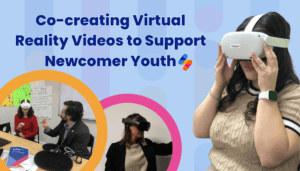This post includes contributions from Nezia Munezero Kubwayo, Dr. Stephanie Akoumany, and Jessica Chapman. This post is the first in a series on “Talking about Race and Racism;” see Tips for Participating in Introductory Conversations and Tips for Conversations with Refugee Youth for additional guidance and resources.
Refugee service providers play an important role in helping newcomers integrate into communities across the country. As they adjust to their new lives in the U.S., many refugees and their family members are likely to experience racism or discrimination first-hand. Refugees need to understand how they may experience racism personally and also how they may encounter racist policies and ways of thinking in their new communities. This is needed to prepare clients not only for the interactions they may have themselves, but also for the news and media they will hear and see. Protests, police brutality, and rioting are potentially traumatic emotional triggers for those who have fled war and unrest. Furthermore, for individuals who have limited English proficiency, understanding what is going on in the news can be challenging and frightening.
What is the role of providers?
In our role as providers, managers, and evaluators of services that help newcomers successfully integrate into U.S. communities, we must be willing and able to have meaningful conversations about race and racism with refugees. Key topics include: the history of race and racism in America, including slavery; historical race-based policies like segregation, redlining, and race-based immigration quotas; and contemporary examples of racism, such as those related to housing and home ownership, education, health care, financial well-being, and how racism undermines access to opportunities.
Talking about race, racism, and anti-racism is complex and requires work at the individual, interpersonal, organizational/institutional, community, and systemic levels. In this blog post, we provide insight and resources for refugee service providers who want to have conversations about race with their clients on the first three levels: individual, interpersonal, and organizational.
Introducing conversations about race as part of refugee service programming requires commitment to introspection, and we must approach these conversations with respect. Individuals and organizations must first recognize that they also have their own biases and commit to learning and growing as they understand more about their own relationships with race and racism. Organizations must also assess current systems, policies, and procedures within their organizations that may reinforce racial biases.
“We overlook ourselves in the equation so much. We put it on society, or schools, or agencies to fix racism or inequity, but it starts with us.” – Dr. Stephanie Akoumany
At an individual level, service providers must become aware of implicit and explicit biases they have related to race. Implicit bias, or unconscious bias, is the brain’s automatic association of stereotypes or attitudes about particular groups, often without conscious awareness. Explicit bias, on the other hand, is an attitude or belief about a person or group on a conscious level. It’s important that service providers who want to have conversations about race with refugees first acknowledge their own biases, so they are able to avoid making assumptions about someone else’s lived experiences. All individuals have some form of implicit and/or explicit biases related to race; service providers must frankly acknowledge these biases before addressing and dismantling them. If they fail to do so, they may make unfounded assumptions about their clients and other members of their community, perpetuating racial bias within their communities and the populations they serve.
Do a bias check.
Dr. Stephanie Akoumany is the founder and CEO of Bloom, a company that curates leadership, wellness, and community-building programs for individuals, families, schools, nonprofits, and businesses. Akoumany explains an easy way to get started with doing a bias check is to “close your eyes and think about a time you were discriminated against—even if you identify as a White American—for any part of your identity: the food you eat, your religion, sexuality, color of your skin, or your hair style. Focus on how it made you feel, think about the power—did you have the power to say something? Did you feel like anyone could help? Or, did you feel stuck, disrespected, humiliated?”
By taking a moment to pause and reflect, service providers can show themselves empathy. Providers can apply this same self-empathy when thinking about times they demonstrated bias, whether consciously or unconsciously. Akoumany explains that it’s important to reflect “without judging ourselves; that’s the key to all of this.” She notes that “White guilt, or any kind of guilt, is not helpful. It will not make you less racist.” Individuals should use this exercise as an opportunity for “lifelong learning,” Akoumany encourages. “It’s okay to make mistakes; know you have to try, make it a lifestyle, and look within.” Importantly, service providers should also consider how they can improve and hold themselves accountable, reducing the impact of bias on their clients, communities, and loved ones.
These tools can also help you take the first steps towards understanding bias, privilege, and systemic racism in the U.S:
- Test Yourself for Hidden Bias by Teaching Tolerance. Note that this tool should be used just to help you explore implicit biases, not as a formal evaluation.
- Complete a Personal Privilege Profile by the Interaction Institute for Social Change, 2011. This can help you understand how your background and experiences may have given you advantages or disadvantages, compared to other members of your community.
- Research the role of systemic racism in the U.S., through sources such as Social Justice and Liberation Centered Books, Websites and Articles compiled by Inclusive Therapists. This can help you understand how race has impacted policies and how race shapes the experience of every American, whether they know it or not.
Do your research.
At an interpersonal level, service providers who want to discuss race, racism, and anti-racism with refugee clients need to grow “race equity muscles.” That is, they need to build competence and confidence to deal with race and bias issues when they arise in conversations and interactions. Service providers can develop these “muscles” by educating themselves about how to talk about race. It is important for service providers to do this work themselves rather than relying on others to educate them, or avoiding topics about race altogether. Akoumany calls this “world school” and offers advice for service providers: “Ask them [refugee clients] about their experiences, take notes, be open and honest—show them you are thinking about their journey, their emotional journey. Don’t assume anything; ask them.”
Resources on Race, Refugee Resettlement, and Immigration
Experience of Black Refugees in the U.S. – This July 22, 2020 webinar was organized by TENT Partnership for Refugees and featured Dr. Tsehaye Teferra, Founder, CEO, and President of the Ethiopian Community Development Council (ECDC).
Statement on the Killing of George Floyd – This statement by Refugee Congress shares perspectives on experiences of race and racism in the U.S.
History of Racism and Immigration Time Line (.pdf) – This resource is an excerpt from Teaching for Diversity and Social Justice, Second Edition, Routledge, 2007.
When we are well-educated on a topic, Akoumany notes, we are able to ask thoughtful questions that come from a “true place of interest.” We are able to learn about others’ experiences without feeling uncomfortable talking about topics like race and bias. This will help clients “to feel comfortable, safe, and open to share about themselves, their experiences, and future goals in their new communities.” These resources can help you prepare for conversations about race and racism:
- Glossary of Bias Terms – This list from Washington University summarizes identity, bias, and other helpful terms.
- Racial Equity Tools – These resources include materials on core concepts and the history of racism and movements.
- From Intergroup Resources:
- Talking about Race Resource Notebook(.pdf) – This Kirwan Institute publication covers topics such as framing and the strategic elements of a transformative dialogue on race.
- Race Matters: How to Talk About Race(.pdf) – This document from the Annie E. Casey Foundation is part of the foundation’s Race Matters Toolkit.
- Ten Lessons for Talking About Racial Equity in the Age of Obama(.pdf) – This short series of talking points from The Opportunity Agenda outlines 10 principles that can help facilitate productive communications on racial justice problems and solutions.
- Talking About Race – This platform by the National Museum of African American History & Culture offers resources for educators, parents, and individuals.
Create a race equity culture.
While individual service providers can and must examine their own biases and educate themselves about race and racism, organizations serving refugees must also commit to anti-racism. Leaders of refugee-serving organizations need to show they recognize that addressing race and anti-racism is important in ensuring refugees successfully integrate into communities in the U.S. Akoumany explains this needs to be done in their own words, either in a video or email to their staff. She further explains that it cannot just be the organization leaders who talk about the issue: leaders need to support others in the organization to discuss race, racism, the impacts of racism on services and service delivery, and how to be anti-racist when serving refugee clients.
Below are organizational self-assessment tools to help leaders and their teams reflect and assess the work that needs to be done to create a race equity culture—that is, a culture focused on proactively counteracting racial inequities inside and outside of an organization, creating a more inclusive and equitable environment for refugee clients.
- Racial Equity Impact Assessment (REIA), also known as a Racial Impact Statement (.pdf) – This assessment, developed by the Washington Race Equity and Justice Initiative, can help a program or organization apply an equity lens to its operations, practices, priority-setting, and decision-making. The REIA can be found on pg 56.
- Institutional Assessment Quiz (.pdf) – This quiz, created by the Annie E. Casey Foundation, is presented as a checklist and lists features that characterize organizations at different “places” in terms of how they focus or do not focus on race and ethnicity. It provides a shared starting place for organizations. The checklist can be found on pg 40.
- Organizational Self-Assessment Related to Racial Equity – This self-assessment and guide was created by The Coalition of Communities of Color. It is meant to help organizations gather baseline data and information in order to self-identify areas for organizational change and improvement.










